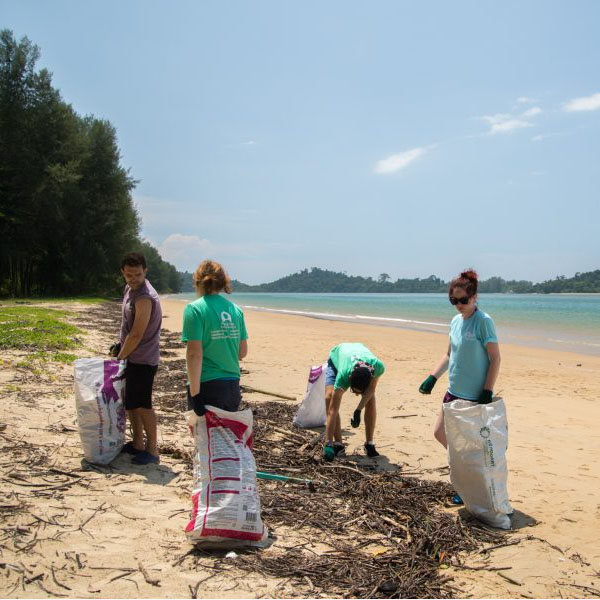In 2018, ‘single-use’ was named the word of the year by Collins Dictionary.
‘Plogging’ – jogging while picking up litter – also made it into the dictionary. (As did an updated description for ‘flossing’, but we’re studiously choosing to ignore that one!).
This evolution in language is indicative of just how far the dialogue on plastics has come, pervading how we think and changing our purchasing habits. But what is more inspirational is how some governments have gone a step further, by passing laws to ban plastics altogether from their countries, oceans and eco-systems.
This July, in honor of Plastic Free Month, we thought we’d celebrate the destinations that are making serious waves in the fight against plastic pollution. From Italy to Indonesia, we salute you!
Capri, Italy

Famous for its stunning blue grotto, high-end beach clubs and café-strewn piazzas, the Italian island of Capri is a mecca for beach and ocean lovers. In an effort to protect its precious flora and fauna, in May 2019, the island introduced a law forbidding the use of disposable plastics, including plates, cups, straws, bottles and food packaging. Businesses were given 90 days to use up their existing stock, and fines of up to €500 will be enforced in order to implement the ban.
Rwanda

The West could learn a lot from Rwanda. This small East African country banned non-biodegradable polythene bags back in 2008. The fact that the first country to ban plastic bags was a developing nation, and that it was implemented over a decade ago, should be an inspiration to the rest of the world.
The ban is rigorously enforced, so fully expect to have your backpacks searched at airports and borders, and any old plastic bags containing your dirty washing confiscated! However, this heavy policing has paid off. Rwanda is noticeably clean. Not only do you not see the piles of roadside rubbish that can plague other countries, but this approach to waste and sustainability has become ingrained in Rwanda’s national psyche.
Bali, Indonesia

Last year, the shocking images of divers swimming through a sea of plastic off Bali’s beaches went viral on our social feeds, and helped to prompt a big reaction. In December 2018, Bali’s governor announced that after a six-month grace period for businesses, the island would be enforcing a ban on single-use plastics, including shopping bags, straws and Styrofoam cups.
After China, Indonesia is the world’s second biggest polluter of marine plastics. It’s hoped that this ban could help to reduce Bali’s plastic pollution by up to 70%, and that it will inspire other parts of Indonesia to follow suit.
Costa Rica

A haven of eco-tourism, Costa Rica is a global leader in sustainability and green practices. In 2015 and 2016, the country powered itself for more than two thirds of the year using 100% renewable energy, and aims to be carbon neutral by 2021.
On World Environment Day in 2017, Costa Rica announced a new national plan to eradicate all single-use plastics by 2021 and become the world’s first plastic-free country.
Chile

In a move to help break a culture of throwaway plastic, in 2018, Chile passed legislation to become the first country in South America to ban plastic bags. This came off the back of previous legislation that had banned plastic bags in Patagonia to try and help protect the region’s national parks and marine life.
Under the new law, businesses have been given two years to adapt to the new legislation, and in the interim, have been limited to giving shoppers a maximum of two plastic bags.
Machu Picchu, Peru

There have been numerous attempts in the past to help preserve the lost Incan city of Machu Picchu, including a permit system to limit the visitors allowed onto the ancient UNESCO site.
In December 2018, Peru’s National Service of National State-Protected Areas (SERNANP) passed a decree to forbid the use of single-use plastics on the Inca Trail and 76 natural protected areas nationwide, including Manu National Park and the coastal reserve of Paracas. Travellers are encouraged to take canteens, refillable bottles and cotton bags instead.
Koh Samet

In November 2018, the authorities of the tiny island paradise of Koh Samet launched a campaign to stop travellers from taking plastic bags and Styrofoam onto the island.
It’s estimated that Koh Samet receives 1,500 visitors a year, with each using an average of eight plastic bags during their stay. While the campaign is an environmental one, and not a legal one, it’s a groundbreaking move by the National Parks, Wildlife and Plant Conservation Department, who have committed to reduce the use of plastic bags and Styrofoam in all of Thailand’s 154 national parks.
Shout out to the rest of the world…
Other places that are tackling plastic pollution head on, by either banning plastic bags, taxing them or charging for them, include San Francisco, Boston, Seattle, UK, Kenya, South Africa, Aruba, Dominica and some states in Australia. In fact, we are happy to announce that the full list is too long to print in full!
How you can further help reduce plastic in paradise
- Commit to a beach clean-up, every time you’re on one. You know how lovely it is to wander up and down the beach, combing it for interesting shells to take home as souvenirs? Well, stop. That’s stealing. Take home the plastic instead.
- Buy food, fruit and snacks from markets and local vendors. They need your custom more than the 7-Elevens do anyway. Plus, drinking coconut water fresh from the coconut > drinking it out of a bottle. Sans-plastic straw, of course.
- Carry a reusable water bottle or flask everywhere. Just because hot countries require you to drink five litres of water a day, it doesn’t mean you need to go through five litres worth of plastic.
- Check out our eco-packing guide.
- Or go buy some of these super kind-to-the-oceans travel gifts.

